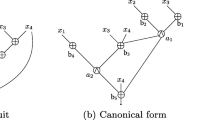Abstract
Every Boolean function may be represented as a real polynomial. In this paper, we characterize the degree of this polynomial in terms of certain combinatorial properties of the Boolean function.
Our first result is a tight lower bound of Ω(logn) on the degree needed to represent any Boolean function that depends onn variables.
Our second result states that for every Boolean functionf, the following measures are all polynomially related:
-
o The decision tree complexity off.
-
o The degree of the polynomial representingf.
-
o The smallest degree of a polynomialapproximating f in theL max norm.
Similar content being viewed by others
References
J. Aspens, R. Beigel, M. Furst, and S. Rudich, On the expressive power of voting polynomials.Proc. Twenty-third Ann. ACM Symp. Theor. Comput., 1991, 402–409.
R. Beigel, N. Reingold, and D. Spielman,The perceptron striles back. Technical report YALEU/DCS/TR-813, Yale University, 1990.
J. Brook and R. Smolenski, Polynomial threshold functions,AC° functions and spectral norms.Proc. 31st Ann. IEEE Symp. Found. Comput. Sci., 1990, 632–642.
E. W. Cheney,Introduction to approximation theory. McGraw-Hill Book Co., 1966.
M. Dietzfelbinger, M. Kutylowski, R. Reischuk, Exact Time Bounds for Computing Boolean Functions on PRAMs Without Simultaneous Writes.Symp. Parallel Algorithms and Architecture, 1990, 125–137.
H. Ehlich andK. Zeller, Schwankung von Polynomen zwischen Gitterpunkten.Mathematische Zeitschrift 86 (1964), 41–44.
J. von zur Gathen and J. Roche, Polynomials with two values.Preprint (1993).
J. Kahn, G. Kalai, and N. Linial, The influence of variables on Boolean functions.Proc. 29th Ann. IEEE Symp. Found. Comput. Sci., 1988, 68–80.
N. Linial, Y. Mansour, N. Nisan, Constant depth circuits, Fourier transform and Learnability.Proc. 30th Ann. IEEE Symp. Found. Comput. Sci., 1989, 574–579.
E. Kushilevitz and Y. Mansour, Learning decision trees using the Fourier transform.Proc. Twenty-third Ann. ACM Symp. Theor. Comput., 1991, 455–464.
M. Minsky andS. Papert,Perceptrons. MIT press, Cambridge, 1988 (Expanded edition). First edition appeared in 1968.
N. Nisan, CREW PRAM's and decision trees.Proc. Twenty-first Ann. ACM Symp. Theor. Comput., 1989, 327–335.
A.A. Razborov, Lower bounds for the size of circuits of bounded depth with basis (and,xor).Math. Notes of the Academy of Sciences of the USSR 41(4) (1987), 333–338.
T. J. Rivlin andE. W. Cheney, A comparison of Uniform Approximations on an interval and a finite subset thereof.SIAM J. Numer. Anal. 3(2) (1966), 311–320.
R. Smolenski, Algebraic methods in the theory of lower bounds for Boolean circuit complexity.Proc. Nineteenth Ann. ACM Symp. Theor. Comput., 1987, 77–82.
J. T. Schwartz, Fast probabilistic Algorithms for verification of Polynomial identities.J. Assoc. Comput. Mach. 27 (1980), 701–717.
I. Wegener,The complexity of Boolean functions. Wiley-Teubner Series in Comput. Sci., New York-Stuttgart, 1987.
Author information
Authors and Affiliations
Rights and permissions
About this article
Cite this article
Nisan, N., Szegedy, M. On the degree of boolean functions as real polynomials. Comput Complexity 4, 301–313 (1994). https://doi.org/10.1007/BF01263419
Received:
Issue Date:
DOI: https://doi.org/10.1007/BF01263419



